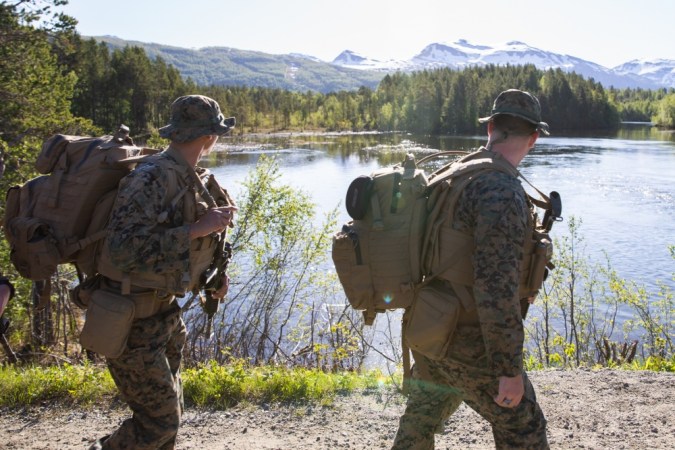Ah, the beloved ruck march. First, you get to center 35 or more pounds of gear on your back and feel the straps dig into your shoulders. Then you start walking until it becomes challenging… then it stops being fun… and then it finally becomes a great reason to never sign a contract with anyone ever again.
Here are seven miseries that are easy to forget about “advanced hiking.”

Every step, those blisters get a little larger — until they pop, tear, get filled with salt from sweat, and potentially get infected.
(Photo by U.S. Combined Division Chin-U Pak)
The feeling of a blister slowly growing across your feet
The most well-known consequence of a ruck march is those vicious blisters that are sometimes shared in photos on social media. While the pain of dealing with them is well-known, there’s an acute feeling of dread you experience during the ruck march. You can feel the skin separating and the fluid-filled bulge growing larger and larger as you march until — a sudden relief followed by a wet feeling lets you know it popped.
Guaranteed, the burning and stinging will grow worse within another mile of marching.

You think it hurts now? Just wait till you try to get out of bed like, ever again.
(Photo by U.S. Air Force Staff Sgt. Caitlin Conner)
The way your legs don’t quite work for two days afterwards
No matter how much water you drink and how much you stretch before and after the ruck march, your legs are going to be wobbly and uncertain for days. It’s like running a marathon. You’re going to end up in pain no matter how well you trained for it.
Just embrace it. Plan to spend a couple of days on the couch — ordering out for food — immediately following the march. Unless you have duty, then just be sad.

There’s always a faster ruck runner.
(Photo by U.S. Army Gertrud Zach)
The knowledge that, no matter how hard you push yourself, that freak in 2nd platoon is going to beat you by 30 minutes or more
You trained, you prepared, you sucked down those stupid packets of goo, and you set a personal record of 2:37 for a twelve-miler. Congrats. You came in over an hour before the cutoff, likely made your platoon proud, and lost to Capt. Jason Burnes by only an hour. If you don’t want to compare yourself to the Air Assault School record holder, then just look to your sister platoon where some corporal is kicking himself for not breaking the two-hour mark.
Oh well. You outscored him on marksmanship. Or the ASVAB. Probably. Maybe…

This dude looks like he’s been waiting all morning to yell at someone for being three ounces under.
(Photo by U.S. Air Force Misuzu Allen)
The fear of over or under-packing your ruck
For a lot of military schools and unit events, the ruck weigh-in takes place after the march, meaning that you can conduct the entire march in record time and then have your finish invalidated because your scale at home said the ruck was 35.2 pounds but it was actually 34.6 pounds, making you a cheater.
This leads to every marcher standing over their scale the night before a march, agonizing over whether to pack 5 more pounds than required — guaranteeing that they’ll pass weigh-in — or pack as close to the cutoff as possible and roll the dice. Fingers crossed.

See how he’s sweating but there’s ice on his weapon? Not fun.
(Photo by U.S. Army Sgt. 1st Class Vincent Abril)
Everything is soaked in sweat, even if it’s freezing outside
It’s hours of laborious walking with, generally, a full uniform on. There’s no way to finish a ruck march without being drenched in sweat.
Even when it’s freezing outside, the slow build-up of body heat guarantees a coating of sweat. Bonus: That sweat will eventually dry and leave a layer of salt on the skin, making the crotch chafing and blisters that much worse.

“Yeah, I’ll pace you, dude. But like, on a bicycle — it’s too hot for this.”
(Photo by U.S. Army Staff Sgt. Lerone Simmons)
There’s no “good weather” for a ruck march
As we hinted above, cold weather will reduce sweat buildup, but it won’t get rid of it. And dressing for a cold-weather march means balancing the need to get through the first two miles without frostbite and the need to not die of heat exhaustion on mile 13 (pro-tip: wear as little snivel gear as you can survive the first three miles in). The best a marcher can hope for is little precipitation combined with fall-like temperatures and humidity.
Even in ideal conditions, you’ll still be hot as hell by the end of it, though. If you start in hot weather, just drink water and imagine you’re in Miami, the rainforest, or the center of the sun. Any of those would be cooler than how you’ll feel at the finish.

“You did it! Grab some water and an orange. Your next ruck march is tomorrow.”
(Photo by U.S. Air Force Airman 1st Class Elizabeth Baker)
You’ve got another one coming up, probably sooner than you think
Of course, the worst part of doing a ruck march is knowing that you’ll have another one coming up, especially for people competing for school slots. Earned a coveted slot for air assault by setting a battalion record on the 12-mile? Congrats!
Remember, you’ll be verifying your performance the week before you ship to school. And you have to ruck in school. And the battalion is working on a ruck march to celebrate all the new graduates for the day after they return from school.










